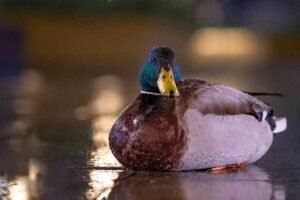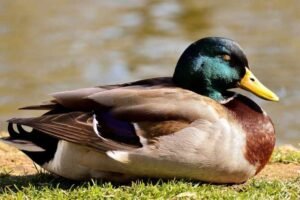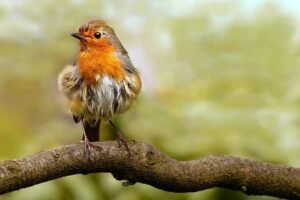It is not wise to put anything in your bird box. If you wish to attract a specific species, use the bird’s favored materials to build its nest. You can set the foundation with wigs, grass, wood chipping, and leaves but don’t just put anything in there. Research the species and figure out its nesting preferences.
What you put in your bird box helps a bird in its nesting process. It also provides the bird a quick way to get up and fly away in no time. Your selection of nesting material defines whether the birds will use your bird box or not. Birds are smart enough to build their nest, and they are resourceful too. So you need to be very careful with the bird nest material to attract them towards your kind gift.
As a bird’s admirer, it is totally normal to think about the comfort of our garden visitors. That’s why many people struggle with the selection of nesting materials in their bird boxes. Some enthusiastic newbie wildlife lovers tend to throw anything in their bird box, making it highly uncomfortable for the intended species.
So, what to put in a birdhouse? And how to make a bird’s nest more comfortable?
Let’s find out!
Should I put anything in my bird box?
Most bird boxes fail because birds don’t use a nest that does not mimic their natural environment. They prefer a wooden box surrounded by bushes and trees. Many people mistake that they put bits of wood inside the box, making the bird highly suspicious of the box.

If a bird considers using your bird box, it will probably throw anything that’s in there to fill it with its preferred nesting material. Therefore, it is suggested not to put anything in your bird box. If you still wish to help, leave the nesting material near the nest, and the birds will take care of it.
Most wild birds are perfectly capable of taking care of their nest building. They don’t appreciate any help from humans.
However, some birds do require your help with their nest building. Birds like Willow Tit, Owls, and Woodpeckers happily accept our interventions. But make sure your bird box has all the necessary materials to imitate their wild habitat. Don’t overfill the box and lay a light foundation on the floor. Focus on the foundation and cover it with dead leaves, twigs, or grass. Leave the rest to the birds, and they will line it with feathers.
While setting up your bird box, make sure you only cover the floor. Do not cover the ventilation or drainage holes. And do not fill the bird box up to the entrance hole.
Nest building is a delicate operation. It requires time and energy to provide a bird with a nest they like. Birds are picky with their nesting materials. It’s better to look at a species’s nesting requirements before setting up a bird box.
What to put in a birdhouse?
While preparing a bird box for your garden visitors, it is best to prefer natural materials. The foundation for most bird species should be wood chipping, twigs, bark, leaves, and grass. Most of these materials are easily available from your backyard.
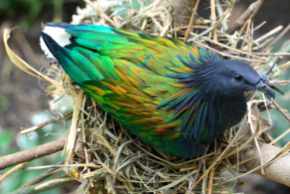
Your task is to layer a light foundation to welcome the birds. And that is it. Now it’s up to female wild birds to step in your bird box and line the foundation with feathers and other materials they usually prefer to build their nest.
You can also welcome some big birds like owls and woodpeckers to your intervention by laying a foundation of sawdust and wood chippings.
Birds like starlings are not fussy. They just require an untidy foundation, and they will gladly nest in your bird box.
Here are some nesting materials preferred by garden birds:
- Toy stuffing
You can cut open a stuffed toy and nail it to a nearby tree. Your garden birds will be glad to make good use of the stuffing. It can help them insulate their nest.
- Pet hair
So you have a furry little fellow in your home who sheds a lot? Perfect!
Small birds collect clumps of pet hair to build their nest. It makes the nest comfortable for their eggs and hatchlings. Just put your pet’s shredded hair near your birdhouse. The birds will happily make it a part of their nest.
- Twine or string
Birds are excellent weavers. They use short lengths of twines to build their nest. They can easily thread it into their nest structure.
- Wood shavings
Wood shavings from any woodwork project can provide good insulation for the nest. You can also use sawdust and shavings from your pet bedding.
We recommend using wood for birdhouses as other materials such as metal or plastic do not provide enough insulation. Wood provides sufficient insulation, so the eggs and hatchlings don’t get chilled in cold weather. Plus, it makes sure the birds don’t overheat in sunny weather.
- Mud
Some garden birds like blackbirds use mud to line their nest. You can consider leaving some mud near the box to help these fellows.
Birds are highly resourceful. They are clever, that’s why they have been surviving for all these years without our help. These smart creatures will find what they need for their nest. But it is fun watching them take the things you leave out for them.
Most functional birdhouses for different species
We will be completely honest here. No matter how comfortable materials you use to fill up your bird box, most birds will not approve it. Except for owls or willow tits, wild birds do not welcome people providing a nest for them.
Quite often, it happens that people are not properly educated about the nesting materials. They unknowingly use poisonous materials that can harm the bird. Therefore, it is crucial to know about the common natural materials used by wild birds to set up their nests. Simply lay a light foundation using the materials mentioned earlier and let the female birds take over the lining process.
Below we have listed some nesting requirements for different species. You can have a look here to create a perfect nesting place for different species.
- Robins

For robins, you can start with a 1-inch-thick foundation of dried leaves. Make sure you are not overflowing the box with excessive leaves. This is particularly good if your entrance hole is shallow to the floor.
The leaves must be dry, so they don’t rot the box interior. You can use leaves of different kinds to satisfy the needs of Robins.
- Wrens
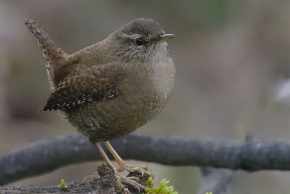
Wrens and Robins, both birds, have similar nesting preferences. Wrens prefer a bird box similar to Robin’s box but with a big rectangular entrance hole.
Wrens are notorious for stealing a bird box already occupied by Robins. But unlike Robins, they do not fill their nest with dried grass and twigs. They just use feathers so you can build a foundation with a larger layer of leaves.
- Tit Family
Birds from the tit family are connected through a closer bond, but their nesting habits are different.
The Crested Tit likes to line their nest with light materials. They put deer fur and hair on top of a wood chipping or grass foundation.
Crested Tit
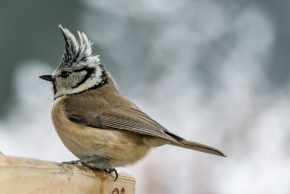
The Willow Tit is amongst the non-fussy birds. These birds appreciate our effort to fill their bird box for them. You can use soft excavatable materials for their nesting sites so they can easily change them later.
Female willow tit uses soft rotten wood as the foundation. It would be great if you can use such materials.
Willow Tit
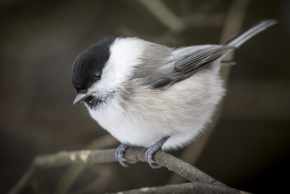
Long-tailed tits are famous for their remarkable nest-building abilities. They use a feather lining. Long-tailed tits also use some man-made items such as paper. You can provide these materials near their nest.
Imitating a long-tailed tit’s nest is a little challenging. We suggest you should leave it to the birds.
Long-tailed tit
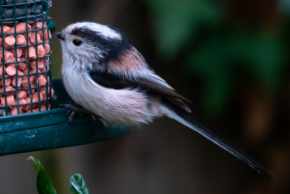
Other members of this family are Blue Tit, Coal Tit, and Great Tit. These members will be happy with the foundation of soft and dried grass.
- Sparrows

Sparrows are famous for building untidy nests. Their preferred materials are grass, feathers, and straw.
Tree sparrows will gladly move into a birdhouse lined with their naturally preferred materials.
House sparrows prefer an incredibly untidy nesting structure. Just lay the foundation of their box with dried grass, and they will continue from there.
- House Martin
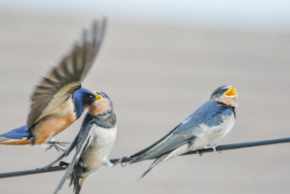
For house martins, you may want to use a half-shelled shape bird nesting box. Put the box under the eaves of your house. Leave the choice of material to the bird.
- Jackdaw
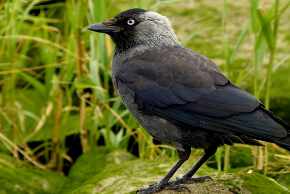
In the wild, jackdaws use heaps of twigs lined with grass as their nest. They also build up their interior with a bunch of dried grasses.
While lining a Jackdaw’s birdhouse, make sure the ventilation and drainage holes are open.
- Starlings
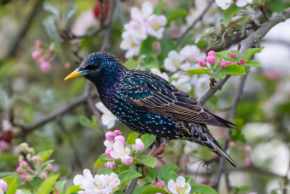
Male starlings use grass in a careless manner for the foundation of their nest. The female starlings then make the nest tidier with feather lining.
Building the foundation for a starling nest is incredibly easy. You just have to use some grass straws, and you are done!
While setting up a starling nest, you may need to position a hole near the top with a lot of space below it.
For starlings, we suggest building up a 2 to 3 inches foundation.
- Owls
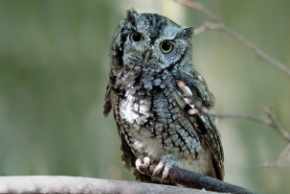
Setting up a bird box for owls is fairly easy. All you need is a significant amount of wood chippings and sawdust. The foundation must be 2 to 3 inches. You can use sawdust from natural woods such as oak, plywood, pine, or beech. But don’t use MDF as it will be hard for the owls to breathe in fine dust.
- Woodpeckers

Woodpeckers follow the nesting pattern of owls. They also prefer 2 to 3 inches of sawdust and woodchopping for their floor.
How to attract birds to birdhouses?
Now that you know what you should and shouldn’t put in your bird boxes, the next step is attracting birds to your birdhouse.
Here is what you can do:
- Install multiple birdhouses
Setup multiple bird boxes throughout your garden. Make sure the entrance hole size is different in each box.
- Attract multiple species
Always select bird boxes that attract multiple species.
- Attract friendly nesting neighbors
Some bird species don’t like to nest next to each other. While setting up the boxes, make sure you know about neighboring species.
- Add a birdbath and Berry bushes.
You can attract a lot of nesting birds by offering some variety. Simply plant different kinds of flowers and keep your birdbath clean and sparkling.
- Select a good nesting location
Every bird has some unique habitat requirements. Some Birds prefer a nesting site surrounded by open fields, while others prefer houses in thick areas surrounded by trees and shrubs. So keep the bird in mind while setting up its nest.
- Attract birds to the right size box
Small bird species required small birdhouses and vice versa. Make sure you know about the exact nesting site requirements of different species.
- Check the entrance hole size.
The entrance hole is an important aspect that helps a bird select the right house for nesting purposes. It helps the small birds to stay in comfort as the big birds cannot fit through small openings. Plus, don’t forget the ventilation holes.
- Place the birdhouse at the right height.

Birds prefer different nesting heights. For example, Purple Martins prefer a height of around 15 to 20 feet, while bluebirds build a nest 5 to 8 feet above the ground.
Wrapping up
Putting a birdhouse up and watching colorful birds flying out of it is fun. This whole experience is really exciting, but the box must be filled with the right materials for the birds to use it. Don’t put random things in your bird box. Don’t put the birdhouses too close to each other. And finally, when the birds leave the nest after a successful brood, make the birdhouse clean ready for the next guests.

